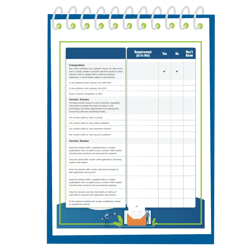Procure-to-pay (P2P) is a process that involves managing and controlling the purchase of goods and services from suppliers through to payment. A P2P vendor portal facilitates this process by enabling companies to manage procurement activities and automate payment transactions with their suppliers. In today's fast-paced business world, the value of having the right P2P vendor portal cannot be overstated. Organizations can streamline their procurement process by selecting the right vendor portal, which, in turn, improves collaboration with suppliers, and reduce costs.
However, with so many vendor portal options available, it can be overwhelming for organizations to determine which one is the best fit for their needs. The following blog post will outline the key features that organizations should look for when selecting a P2P vendor portal.
Are checklists more your style? Skip ahead and get your top 15 features in a ready-to-go checklist.

What Is a Vendor Portal?
A vendor portal, also referred to as a supplier portal, serves as a centralized digital hub where organizations can seamlessly collaborate with their vendors. By harnessing the power of the Internet, these platforms streamline communication, facilitate information exchange, and ultimately boost operational efficiency.
Organizations and government agencies that frequently interact with a multitude of vendors across different operational areas greatly benefit from vendor portals. These platforms provide a structured and systematic approach, ensuring smooth coordination and productive relationships within a larger supplier network.
Key Features of a Procurement Portal
A procurement portal offers a range of key features that streamline vendor management and enhance procurement processes. These portals enable vendors to easily enter their information, submit necessary documents, track their current status, and communicate with the organization, fostering efficient collaboration. One of the primary advantages of a procurement portal is simplified vendor document and contract management. By centralizing all vendor-related documents, such as W-9 tax forms, vendor invoices, purchase orders, and other essential paperwork, businesses can avoid costly errors and ensure compliance with contractual obligations.
In addition to document management, procurement portals excel in supplier management by simplifying various procurement functions and business processes. From onboarding new vendors to issuing purchase orders, managing invoices, handling payment disputes, and even handling dynamic discounts, these portals offer comprehensive tools for effective vendor management. Furthermore, they enable organizations to track lead times and deliveries, ensuring smooth supply chain operations and timely fulfillment of orders.
Functionality
A critical aspect of any procure-to-pay vendor portal is its functionality. A good platform should provide a comprehensive set of features and tools that make the procurement process efficient and effective. Here are some key features your team should look for evaluating the functionality of a P2P vendor portal:
1. Ease of use
First, you should consider in your search is the ease of use. A user-friendly interface and intuitive navigation can greatly enhance the overall experience for users and suppliers. Look for a portal that offers a simple and streamlined user interface with easy-to-understand menus and clear instructions. Consider testing out the platform with a trial or demo version and see what your team has to say.
More details can be found in our on-demand webinar, where two supply chain experts share their experiences in evaluating a vendor portal for an enterprise.
2. Customization
Another important feature to consider is customization. Every organization has unique needs and workflows, so it's essential to select a vendor portal that can be tailored to fit those requirements. Look for a portal that allows for the customization of fields, workflows, and processes and provides the ability to create custom dashboards. The more flexibility you have to customize the platform, the more effective it will be in meeting your specific needs.
3. Automation Capabilities
Automation is a key feature of a good P2P vendor portal. Automated processes can greatly reduce manual labour and minimize errors, ultimately improving efficiency and reducing costs. Look for a platform that offers automated workflows for purchase orders, invoices, and payment approvals. Additionally, automation features such as automated notifications and reminders can help ensure timely approvals and payments.
Security
When evaluating a P2P vendor portal, security is a critical consideration. The platform should be designed to protect sensitive data, maintain privacy, and prevent unauthorized access. Here are some key security features to look for in a P2P vendor portal:
4. Data Encryption
Data encryption is a critical feature for protecting sensitive information. Look for a vendor portal that uses encryption technology to secure data during transmission and storage. This ensures that data is protected from hackers and other unauthorized parties. The portal should use secure communication protocols such as SSL or TLS, and data should be encrypted at rest.
5. Secure Logins and User Authentication
Secure logins and user authentication are essential for ensuring that only authorized individuals can access the P2P vendor portal. Look for a platform that supports strong passwords and multi-factor authentication, such as biometrics or smart cards. This will help prevent unauthorized access and reduce the risk of data breaches.
6. Compliance With Data Privacy Laws
Data privacy laws are becoming increasingly stringent, and organizations must ensure that their P2P vendor portal is compliant with relevant regulations such as GDPR or CCPA. Look for a vendor portal that complies with industry standards and best practices for data privacy and security. The platform should provide tools to manage data access and permissions, as well as auditing and reporting capabilities to monitor compliance.
Scalability
Scalability is another important consideration when evaluating a P2P vendor portal. As businesses grow and expand, they need a vendor portal that can handle increasing volumes of transactions, accommodate changing needs, and provide additional features and functionality. Here are some features to look for when considering scalability:
7. Ability to Handle Increasing Volumes of Transactions
The vendor portal should be designed to handle increasing volumes of transactions as the business grows. Look for a platform that can scale up to accommodate larger volumes of transactions without sacrificing performance or reliability. The vendor should also provide options for additional resources, such as increased storage, processing power, or bandwidth, to support growing business needs.
8. Ability to Accommodate Growth and Change in Business Needs
A good P2P vendor portal should be able to accommodate growth and changes in business needs. This means that the platform should be flexible and adaptable to meet evolving requirements. Look for a vendor portal that can be easily customized to fit specific business processes and workflows and that can be configured to meet changing needs over time.
9. Availability of Additional Features and Functionality
As businesses grow, they may require additional features and functionality to support new processes or workflows. Look for a vendor portal that offers a range of features and functionality to meet current and future needs. This may include advanced reporting and analytics capabilities, integration with other systems, or support for mobile access.
Cost
Cost is an important consideration when evaluating a P2P vendor portal. While the cost of the platform is not the only consideration, it is important to ensure that the platform provides value for money and can deliver potential cost savings. Here are some key considerations when evaluating the cost of a P2P vendor portal:
10. Comparison of Pricing Models
When evaluating the cost of a P2P vendor portal, it is important to compare pricing models from different vendors. Some vendors may charge per transaction or per user, while others may offer flat fees or subscription-based pricing. Look for a vendor that offers transparent pricing models and flexible pricing options to meet your business needs.
11. Evaluation of Value for Cost
When evaluating the cost of a P2P vendor portal, it is also important to consider the value that the platform provides. Look for a vendor that offers a range of features and functionality that can help streamline procurement processes, reduce costs, and improve efficiency. Consider the potential benefits of the platform, such as faster processing times, reduced manual tasks, and improved accuracy, when evaluating the value for the cost.
12. Potential Cost Savings
Finally, when evaluating the cost of a P2P vendor portal, it is important to consider the potential cost savings that the platform can deliver. Look for a vendor that offers tools to help reduce transaction costs, such as automated invoice processing, dynamic discounting, and electronic payments. These tools can help reduce processing times, eliminate errors, and improve cash flow, resulting in significant cost savings over time.
Supplier Management
Supplier management is a critical aspect of the procure-to-pay process, and a good P2P vendor portal should provide robust tools to help manage suppliers effectively. Here are some features to look for in a vendor portal when it comes to supplier management:
13. Onboarding Process
A good P2P vendor portal should have an efficient and streamlined onboarding process for suppliers. This process should include the ability to easily onboard new suppliers, collect and verify supplier information, and set up supplier profiles. Look for a platform that provides automated onboarding processes, document management capabilities, and secure data exchange to ensure that supplier information is accurate and up-to-date.
14. Communication Capabilities
Effective communication with suppliers is essential for efficient procurement processes. A P2P vendor portal should offer robust communication tools that allow for efficient and effective communication between buyers and suppliers. Look for a platform that provides real-time messaging, email notifications, and other communication tools that make it easy to communicate with suppliers, share information, and resolve issues quickly.
15. Vendor Self-Service Options
A good P2P vendor portal should provide self-service options for suppliers. This allows suppliers to access their information, submit invoices, and track payments at their convenience. Look for a platform that provides a secure and user-friendly self-service portal that suppliers can access from anywhere at any time.
Conclusion
Selecting the right procure-to-pay vendor portal is critical for organizations looking to optimize their procurement process. By providing a comprehensive solution for managing the procure-to-pay process, a P2P vendor portal can help businesses streamline operations, reduce costs, and increase profitability.
It is worth noting that not all P2P vendor portals are created equal. Therefore, it is important to conduct a thorough evaluation of potential vendors before making a final selection. Consider the specific needs of your organization and evaluate vendors based on their ability to meet those needs.

